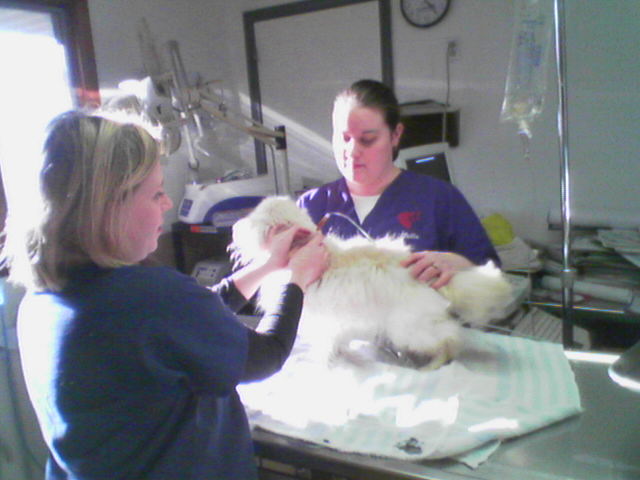|
How to Administer Subcutaneous Fluids

Subcutaneous fluids are administered through a needle under the skin. Most pets tolerate this procedure well, and the added hydration usually makes them feel considerably better.
Safety Tips
- Until you are comfortable with the procedure, ask someone to hold your pet, or confine smaller pets to a box or pet bed and surround the pet with towels to prevent movement.
- Because the loose skin near the neck has very few nerves, it will be less painful to give your pet fluids in this location. Be sure to vary the injection site each time you give fluids.
- Always keep fluids at room temperature for your pet’s comfort.
- Never use a needle twice due to the loss of sterility and sharpness. After using a needle, replace the cap, place it in a thick plastic container, and tape a lid over the top. Ask about returning needles to your veterinary practice for disposal.
Assembling the Fluid Therapy System
A fluid therapy system consists of a fluid bag, drip set, and needle. The fluid contains sterile solution and is labeled in 100mL increments. The drip set includes clear tubing (the fluid line) that connects the fluid bag and the needle. A roller clamp on the tubing enables you to stop or start the fluid flow. The drip chamber at the top of the tubing lets you view the speed of flow.
- Remove the fluid bag and drip set from its packaging. Make sure the roller clam is closed.
- Hold the fluid bag with the sealed end up, and remove the rubber seal.
- Remove the cap from the spiked end of the drip set. To maintain sterility, do not allow the spiked end to touch anything. Insert the spike into the open port of the fluid bag, twisting it in place to prevent leaks.
- Remove the cap from the other end of the fluid line, making sure not to contaminate the tip of the line.
- Unscrew the plastic cap from the needle, exposing the needle’s hub. Firmly seat the hub over the end of the fluid line.
- Hang the bag and open the roller clamp to allow the fluid and air bubbles to run out the end of the needle. Close the clamp.
- Squeeze the drip chamber until it’s half full of fluid. If the chamber fills completely, turn the chamber upside down, and squeeze the chamber to force some fluid back into the bag.
Administering Subcutaneous Fluids
- Hang the fluid bag about 3 feet above your pet. Make sure the roller clamp is closed.
- Using your nondominant hand (e.g., Your left hand if you are right handed), lift an area of loose skin near your pet’s neck.
- With your dominant hand, hold the needle near its hub (where it attaches to the fluid line). Position the needle parallel to the spine with the tip aimed toward your pet’s head and the needle hole facing up.
- Pull the skin away from the spine (“tenting” the skin), and push it toward the needle. Firmly insert the needle into the skin (you will feel a slight “pop”), then release the skin.
- Open the roller clamp. The fluid in the drip chamber should flow quickly. If the fluid is not moving or is dripping slowly, reposition the needle until the fluid flows as fast as possible.
- If you notice fluid on your pet’s coat, chances are the needle isn’t in the skin. Reposition the needle so it is in the space under the skin.
- A fluid pouch will swell under the skin where you are administering fluids. This is normal and will gradually be absorbed. How much fluid you can place in one location depends on the elasticity of your pet’s skin. If the area begins to feel tight, remove the needle and administer the remaining fluid in other locations (e.g., a couple of inches away).
- Close the roller clamp, withdraw the needle, and recap it. It’s common for a small amount of fluid to leak from the injection site. Do not be concerned if the fluid is slightly tinged with blood. Simply pinch the site closed, and hold it for a few minutes until the leaking ceases.
- Depending on your pet’s hydration status, it could take a few minutes or several hours for the fluids to absorb. The fluids may be drawn down to your pet’s lower abdomen or legs. If the fluids have not been absorbed by the time the next fluid administration is due, do not give additional fluids. Consult your veterinarian.
Copyright Fall 2008 Merial
|